Cite this document
(Genetic Modification of Human Beings: Is it acceptable Research Paper, n.d.)
Genetic Modification of Human Beings: Is it acceptable Research Paper. https://studentshare.org/medical-science/1855211-the-research-argument
Genetic Modification of Human Beings: Is it acceptable Research Paper. https://studentshare.org/medical-science/1855211-the-research-argument
(Genetic Modification of Human Beings: Is It Acceptable Research Paper)
Genetic Modification of Human Beings: Is It Acceptable Research Paper. https://studentshare.org/medical-science/1855211-the-research-argument.
Genetic Modification of Human Beings: Is It Acceptable Research Paper. https://studentshare.org/medical-science/1855211-the-research-argument.
“Genetic Modification of Human Beings: Is It Acceptable Research Paper”. https://studentshare.org/medical-science/1855211-the-research-argument.


